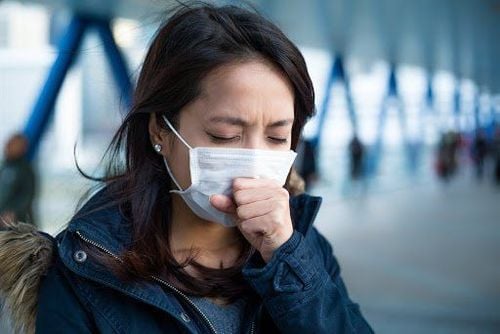This is an automatically translated article.
The article was professionally consulted with Senior Doctor, Dr. Vu Van Tam - Infectious Internal Medicine - Department of Medical Examination & Internal Medicine - Vinmec Ha Long International General Hospital.Seasonal flu is an acute respiratory infection caused by an influenza virus. Seasonal flu is more common in the winter for a number of reasons, such as the flu virus being able to survive better in cold and dry climates and thus infecting more people. So are influenza viruses and flu dangerous and why have there been global flu pandemics?
1. What is the incidence and mortality rate of seasonal flu?
According to the World Health Organization, seasonal influenza (commonly referred to as influenza) is an acute illness caused by influenza viruses and is highly contagious from person to person through droplets when talking, coughing, or sneezing. sneezes or spreads through contact with certain objects with the virus, or through hands touching the mouth, nose, eyes.There are 3 strains of seasonal flu that are influenza A, influenza B and influenza C. In which influenza A is the most dangerous seasonal flu strain with many pathogenic strains such as influenza A(H5N1), A(H3N2), A(H1N1) ... Influenza C causes illness similar to the common cold. There is only one strain of influenza B virus. The prevalence of influenza strains will vary from year to year.
Statistics of the World Health Organization (WHO) show that every year around 5-10% of adults and 20-30% of children in the world are infected with influenza, of which, about half a million people die due to influenza. flu-related health problems. In Vietnam, every year 1-1.8 million people get seasonal flu. Influenza is more severe and causes death mainly in the elderly and in people with chronic illnesses.
Although it is difficult to accurately assess the annual influenza epidemic, it is estimated that 3-5 million people become seriously ill and an estimated 250,000-500,000 people die annually from influenza worldwide. In developed countries, most deaths occur in the elderly over 65 years of age.
According to the latest estimates from the US Centers for Disease Control and Prevention, there are between 290,000 and 650,000 deaths annually related to seasonal flu.
2. Complications of the flu
Seasonal flu is usually benign, however, in some cases can progress to severe symptoms such as high fever, difficulty breathing, pulmonary edema due to heart failure and even death.Anyone can get the flu, but the high-risk group for severe disease and complications is:
People with a history of chronic diseases such as COPD, asthma, heart failure,... People People with reduced resistance such as kidney failure, diabetes, and alcohol abusers. Pregnant women The elderly Children. Seasonal flu, if not treated or treated too late, will make the disease worse, causing dangerous complications such as:
Pneumonia Respiratory failure. In addition, flu also causes complications of otitis media, sinusitis, urinary tract infections. If a pregnant woman gets the flu, it can cause pneumonia or cause a miscarriage. Influenza in the first 3 months of pregnancy can cause complications in the fetus, especially central nervous system disease, but is not teratogenic.
One of the most dangerous complications of seasonal flu in children is Reye's syndrome - this is an acute brain disease and liver dysfunction. Although this complication is rare, it is very dangerous and has a very high mortality rate. Reye's syndrome is most common in children 2 to 16 years of age, and usually occurs a few days after the flu. When flu symptoms seem to be receding, children suddenly develop nausea and vomiting. About 1-2 days later, the child turns to delirium, convulsions and then gradually goes into a coma and possibly death.

Biến chứng của cúm có thể gây viêm phổi
3. Influenza always has the potential to become a pandemic
More than just small annual local outbreaks, seasonal flu can turn into a pandemic. The World Health Organization defines the term as "an outbreak of a new pathogen that spreads easily from person to person globally".So far, according to the statistics we have, the world has experienced many pandemics caused by seasonal flu such as:
The Russian - Asian flu pandemic occurred in 1889 - 1890 with up to 1 million deaths. The Spanish flu pandemic occurred in 1918 - 1920, about one third of the world's population was infected and an estimated 50 million people died, is considered one of the deadliest pandemics in human history. The Asian flu pandemic occurred in 1957 - 1958, causing about 1 - 1.5 million deaths. The Hong Kong flu pandemic occurred in 1968 - 1969, causing 0.75 - 1 million deaths. In the early 20th century, scientists could have predicted that the flu, which twice caused pandemics in the late 19th century, would recur, but we were nearly powerless to stop it. influenza H1N1 of 1918 (H1N1).
Today, knowledge about influenza virus, capacity to research and produce vaccines and antiviral drugs to prevent its spread has greatly developed. However, the world is still vulnerable to the next influenza pandemic, possibly even larger than the one in 1918, because the frequency and density of global trade is much higher than before, making it difficult to Seasonal flu is contagious around the world.
4. Can a person have both the flu and COVID-19 at the same time?
Eleven studies were conducted to assess prevalence with a total of 3,070 patients with COVID-19, and 79 patients with concomitant COVID-19 and influenza were selected for evaluation. The rate of influenza infection among patients with confirmed COVID-19 is 0.8%. The frequency of influenza virus co-infection in COVID-19 patients was 4.5% in Asia and 0.4% in the Americas. However, some other studies have shown that co-infection rates can be very high. A study of 48 Covid-19 patients showed evidence of co-infection in 34 patients (71%). Viral coinfection is associated with increased ICU admissions and higher mortality. Two-thirds of severe COVID-19 patients who died were co-infected, and Influenza A H1N1 was the only pathogen with a direct link to mortality.Although a low proportion of COVID-19 patients are coinfected with influenza, the possibility of co-infection cannot be ignored, especially in high-risk individuals and the elderly. We still need more time and studies to assess how dangerous it is to be co-infected with these two diseases.

Nếu gặp triệu chứng cúm nguy hiểm cần đi khám để được điều trị hiệu quả
5. The COVID-19 epidemic is spreading, so when you suspect the flu, should you go to the doctor?
Currently, the COVID-19 pandemic is spreading all over the world as well as our country. Having COVID-19 and having the flu share some of the same symptoms. So if you have dangerous flu symptoms, you need to go to the doctor right away for timely treatment with antiviral drugs and appropriate measures.Symptoms of dangerous flu in children include:
Children breathing fast, labored breathing, difficulty breathing. Child has chest pain. The child's face and lips are pale and pale. The child is uncomfortable or unable to walk. The child has a dry mouth, has not urinated for 8 hours, or is crying without tears. Children are sleepy and difficult to wake up. The child has a high fever over 40 degrees Celsius. The child has a convulsion. The child has a fever or cough that recurs or gets worse. Children have chronic medical conditions that become more severe and severe. Symptoms of dangerous flu in adults include:
Shallow or difficult breathing Chest pain and abdominal pain. Persistent headache and dizziness Not alert. Do not urinate for many hours at a time. High fever and convulsions. Muscle pain with severity. Weakness, loss of consciousness. Symptoms of fever or cough recur or get worse. People have chronic diseases and these conditions become more severe and severe. And it's important to remember to get a yearly flu shot to protect against flu infection and severe progression, especially in high-risk populations.
6. Where should I get the flu vaccine?
To get the flu shot, you should choose reputable hospitals/vaccination centers, provide quality vaccines, follow the injection process and follow up closely after vaccination, to ensure vaccination safety.Vinmec Hospital provides flu vaccination service with outstanding advantages such as:
Commitment to high quality vaccine source, clear origin, safety assurance from import, storage to use use; Vaccines are preserved by a cold chain meeting GSP standards with a modern cold storage system, allowing vaccines to be kept in the best conditions; Experienced medical team, able to advise and handle complex vaccination situations; Strict process: Before vaccination, customers are screened before vaccination with specialist doctors to help ensure the best health when vaccinated. The doctor will advise the family on the best preventive vaccines, suitable for each age group according to the latest recommendations of the Ministry of Health & World Health Organization as well as how to monitor the reaction after vaccination. ; With the advantage of multi-specialty, Vinmec can effectively monitor and handle post-vaccination problems (if any); Modern facilities: Post-vaccination monitoring room is fully equipped with emergency facilities; The team of doctors - nurses are trained in anaphylaxis emergency treatment to ensure timely and correct treatment when an incident occurs.
Please dial HOTLINE for more information or register for an appointment HERE. Download MyVinmec app to make appointments faster and to manage your bookings easily.













